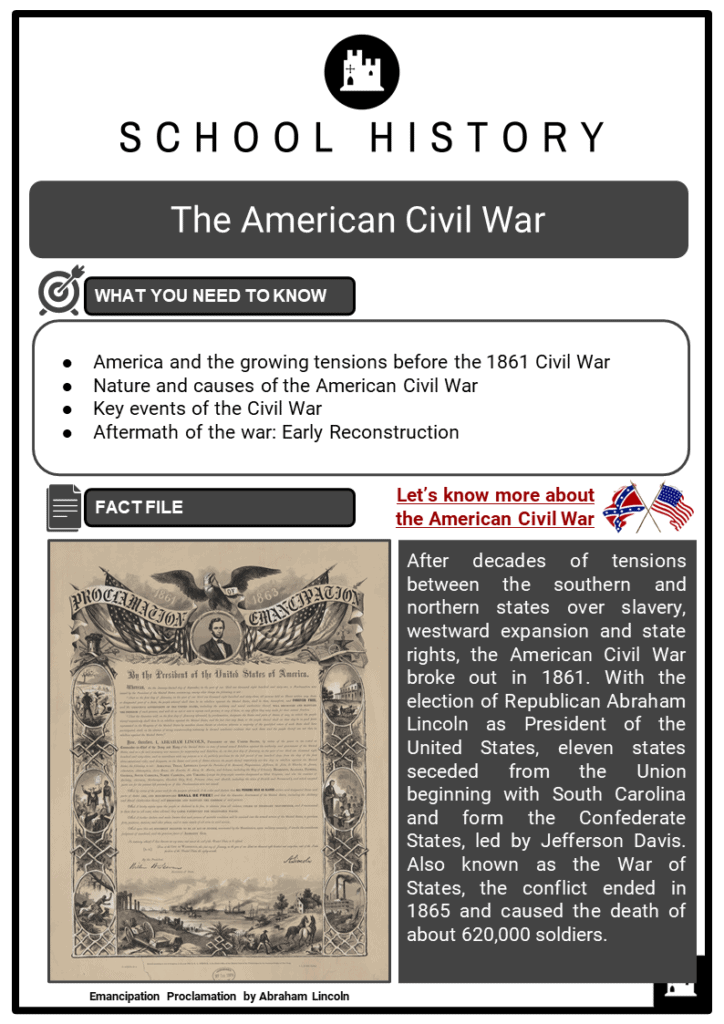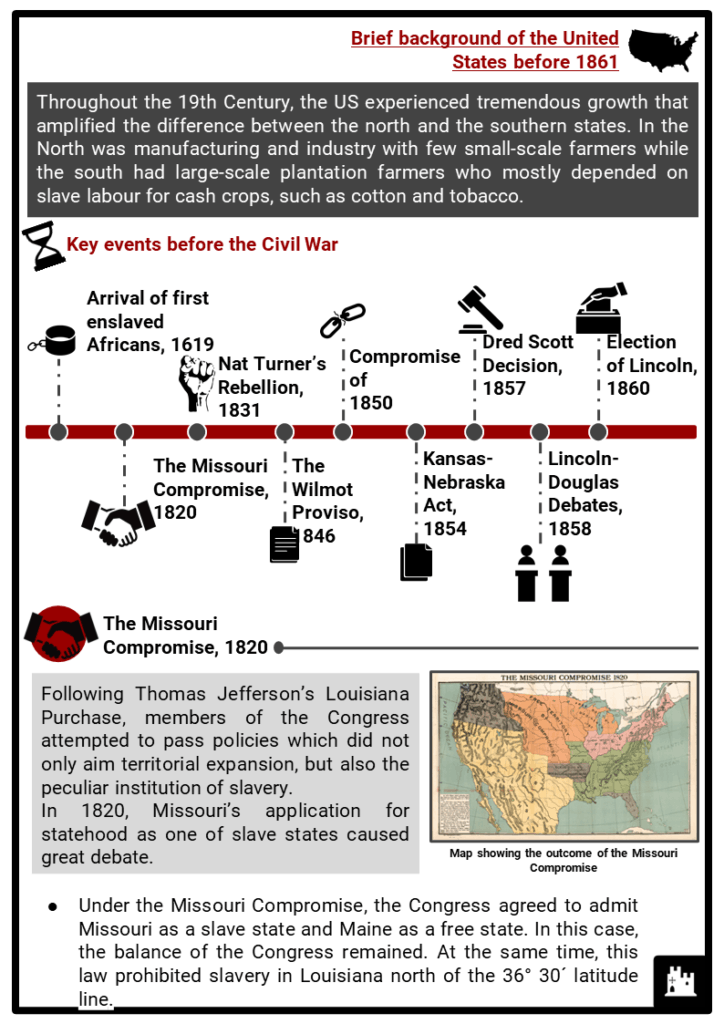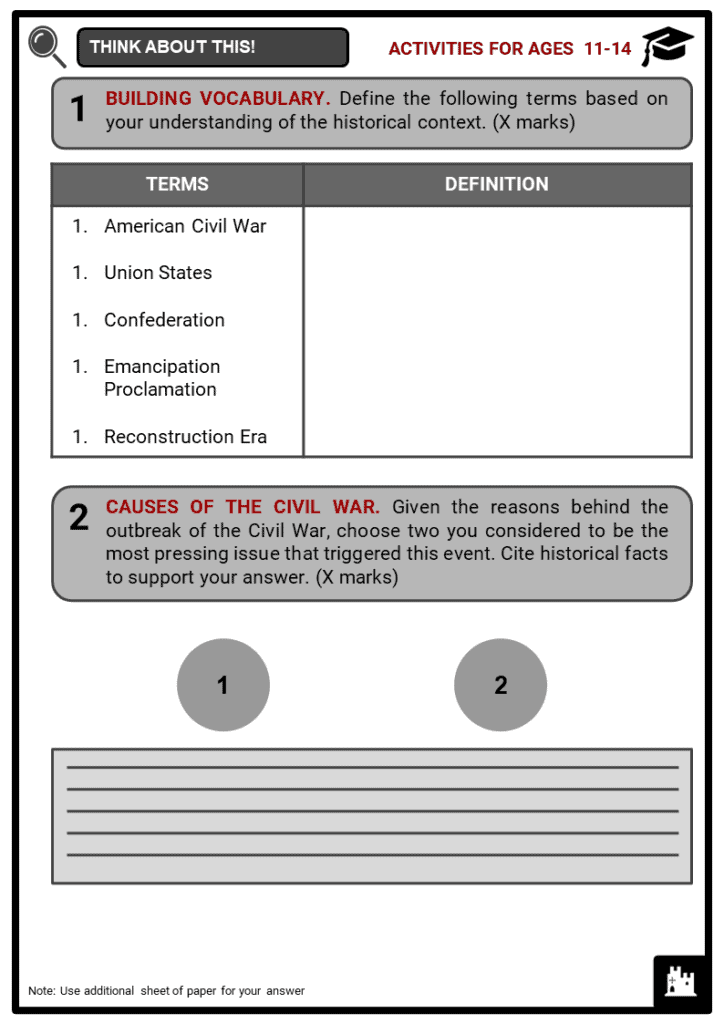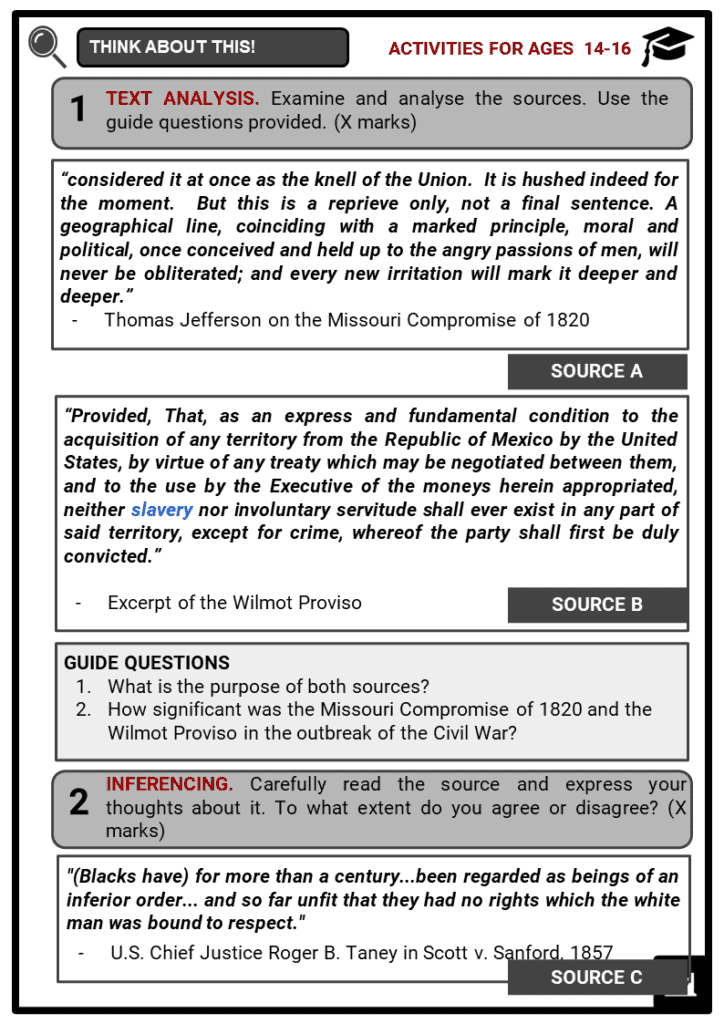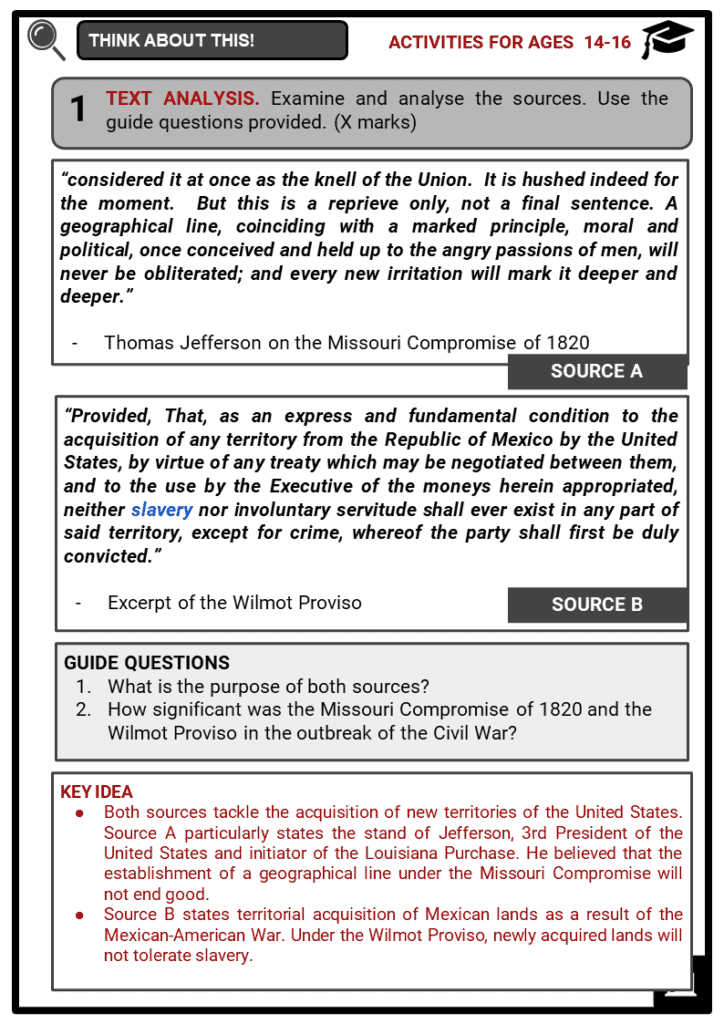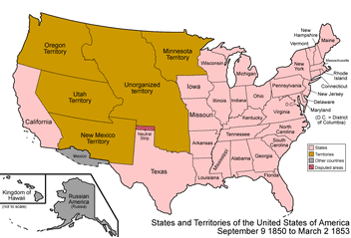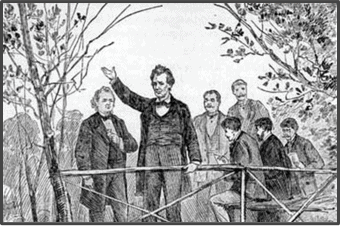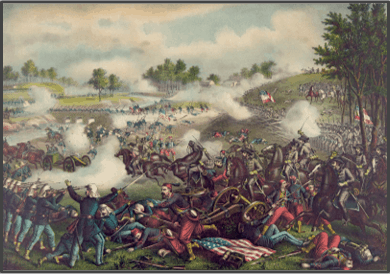Download The American Civil War Worksheets
Do you want to save dozens of hours in time? Get your evenings and weekends back? Be able to teach The American Civil War to your students?
Our worksheet bundle includes a fact file and printable worksheets and student activities. Perfect for both the classroom and homeschooling!
Table of Contents
Add a header to begin generating the table of contents
Summary
- America and the growing tensions before the 1861 Civil War
- Nature and causes of the American Civil War
- Key events of the Civil War
- Aftermath of the war: Early Reconstruction
Key Facts And Information
Let’s know more about the American Civil War
- After decades of tensions between the southern and northern states over slavery, westward expansion and state rights, the American Civil War broke out in 1861. With the election of Republican Abraham Lincoln as President of the United States, eleven states seceded from the Union beginning with South Carolina and form the Confederate States, led by Jefferson Davis. Also known as the War of States, the conflict ended in 1865 and caused the death of about 620,000 soldiers.
Brief background of the United States before 1861
- Throughout the 19th Century, the US experienced tremendous growth that amplified the difference between the north and the southern states. In the North was manufacturing and industry with few small-scale farmers while the south had large-scale plantation farmers who mostly depended on slave labour for cash crops, such as cotton and tobacco.
- The Missouri Compromise, 1820
- Following Thomas Jefferson’s Louisiana Purchase, members of the Congress attempted to pass policies which did not only aim territorial expansion, but also the peculiar institution of slavery.
- In 1820, Missouri’s application for statehood as one of slave states caused great debate.
- Under the Missouri Compromise, the Congress agreed to admit Missouri as a slave state and Maine as a free state. In this case, the balance of the Congress remained. At the same time, this law prohibited slavery in Louisiana north of the 36° 30´ latitude line.
- Nat Turner’s Rebellion,1831
- Nat Turner, a slave in southern Virginia led an uprising of about 70 enslaved African and killed about 60 white people. After two day of terror in several plantations, the militia infantry suppress the rebellion.
- After the insurrection, about 55 slaves were executed. Due to low success rates of slave rebellion in the south, Turner’s Rebellion is considered as the bloodiest.
- Despite the already limited right, lawmakers in Virginia further prohibited slaves from learning how to read and write.
- Moreover, slaves were not allowed to assemble. Working hours in a week were extended to prohibit slave from meeting with one another on Sundays
- The Wilmot Proviso,1846
- Proposed by Pennsylvania Congressman David Wilmot and supported by President James K. Polk, the Wilmot Proviso outlawed slavery in US-acquired territories as a result of the Mexican-American War
- Ceded territories included, California, Utah, Nevada and parts of Arizona, New Mexico, and Wyoming.
- This political measure later inspired politicians, like James Buchanan and John C. Calhoun in their own cause on slavery.
- Compromise of 1850
- With ongoing national debate and souring relations in the Congress over the Wilmot Proviso, Senators Henry Clay and Stephen Douglas pursued the Compromise of 1850
- Under the compromise, ceded territories of Utah or Mexico will be free from federal restrictions on slavery. California added to the list of free states.
- On the other hand, slave states strengthened the enforcement of the Fugitive Slaves Act, which compelled free states to return escaped slaves to slave states. Texas was also compensated by the Congress with $10 million.
-
- Supported by US President Millard Fillmore, the compromise became a law in September.
- Also under the Compromise, slave trade was prohibited in Washington, D.C, but slaveholding was permitted.
- Kansas- Nebraska Act, 1854
- In 1854, Kansas and Nebraska were established as territories. The decision to whether join the Union as a free or slave state lies on popular sovereignty. Under popular sovereignty as proposed by Stephen Douglas, residents of both territories would decide by popular referendum on allowing slavery or not.
- As a result, many northerners and southerners poured into Kansas to increased their number in the debate. In the fall of 1855, pro-slavery and anti-slavery advocates engaged in violence. This event became known as Bleeding Kansas.
- By the time Kansas joined the Union, the Civil War already began in 1861. This act divided Democrats and Whigs which later joined the new antislavery Republican Party.
- Dred Scott Decision, 1857
- In 1857, the Dred Scott decision confirmed the legality of slavery in the southern states and the westward expansion, but the abolitionist movement convinced the southerners that the north was bent on dismantling the institution of slavery.
- Also known as Dred Scott v. Sanford, the case of freedom by an African slave lasted a decade. Dred Scott was born into slavery in 1799 in Virginia. He moved with his owner, Peter Blow to Alabama.
- By 1830, Scott moved to St Louis, Missouri. Both Alabama and Missouri were slave states.
- Two years later, Blow died and Scott was bought by Dr. John Emerson, who later moved him to Illinois and to Wisconsin territory - where slavery was outlawed under the Missouri Compromise.
- While in Wisconsin, Scott married Harriet Robinson, also a slave, who’s ownership was transferred to Emerson.
- In 1837, Emerson met and married Eliza Sanford when he moved to Louisiana, a slave state. After several months, Scott followed Emerson. By October 1838, the Emersons and their slaves returned to Wisconsin.
- In 1843, John Emerson died in Iowa. His slaves became his wife’s property. When Sanford returned to Missouri, he denied Scott from buying his freedom.
- Dred and Harriet Scott filed lawsuits against Irene Sanford in April 1846. Under two Missouri statutes, (1) Any person of any colour is allowed to sue for wrongful enslavement, and (2) Any person taken to a free territory would gain freedom and could not be subjected to slavery if returned to a slave state.
- The Scotts received support from abolitionists, church mates and the Blow family, who once own Dred.
- After retrial in 1850, Scott won his freedom. He lower court’s decision in 1852 was reversed by the Missouri Supreme Court. However, on May 15, 1854, Scott and his family became slaves again after the reversal of the federal court.
- On February 11, 1856, Scott’s trial reopen after his appeal to the US Supreme Court. The following year, he lost his fight for freedom. Chief Justice Roger Taney said that all people of African descent (free or slave) were not citizens of the United States, therefor had no right to sue. Moreover, he justified that under the Fifth Amendment, slaves were legal properties of their owners.
- Lincoln-Douglas Debates,1858
- Between August 21 and October 15, 1858, Stephen Douglas and Abraham Lincoln faced each other in series of debates around the Illinois for a seat in the Senate.
- After 7 debates in several locations in the state, Douglas returned to Washington, while Lincoln was remember as a promising politician.
-
- Douglas argued that the most important decision on whether to permit slavery or not was the actions of the citizens. He stressed that no Supreme Court law could force its citizens. His idea later became known as the Freeport Doctrine, which gained popularity among the people, but equivalent to betrayal for many southern Democrats.
- Lincoln believed that African slaves were entitled to the rights stipulated in the Declaration of Independence. Douglass argued that the America’s Founding Fathers did not include them.
- Election of Lincoln,1860
- With divided Democrats, Abraham Lincoln was elected as the 16th President of the United States in November 1860. He won the election with 180 electoral votes and less than 40% of the popular vote against candidates, Douglas, Breckenridge, and Bell.
- The 1860 election identified the Democratic and Republican Parties. It also intensified the division among slave and free states between the South and the North.
- Carrying anti-slavery platform of the new Republican Party, Lincoln’s election angered pro-slavery politicians. Because of this, even before Lincoln’s inauguration, eleven states seceded from the Union.
Causes and nature of the Civil War
- The American Civil War, widely known in the United States as simply the Civil War, was a war fought from 1861 to 1865 to determine the survival of the Union or independence for the Confederacy. The issue of slavery primarily divided the Northern and Southern states.
- Differences between the North and South
- Prior to the 1861 Civil War, the United States of America was divided between the North and South. Disagreements regarding states’ rights, economy, tariffs, and slavery marked the demarcation line. In addition, continued westward expansion caused concern for the Southerners that new states would be admitted as free states.
- Slavery
- After the Revolutionary War, the original US Constitution acknowledged the system of slavery. Article 1, Section 2, also known as three-fifths compromise, stated that slaves counted as three-fifths of a person for the purpose of taxation and representation in Congress.
- The three-fifths compromise was debated among those who wanted to exclude and include slaves. Including all slaves meant increasing representation in slave states. Since slaves were not allowed to vote, such a representation issue only enabled slave states to count slaves among their population totals.
- Clause 1 of the original Constitution prohibited Congress from passing any laws banning slavery until 1808. It was only in 1807 when Thomas Jefferson, a known slave owner, Founding Father, and later US President, signed a bill banning slave trade. It took effect on January 1, 1808.
- Free states included California, Illinois, Iowa, Minnesota, Maine, New Jersey, New Hampshire, Rhode Island, Oregon, Wisconsin, Connecticut, Pennsylvania, Indiana, Kansas, New York, Nevada, Vermont, Ohio, Michigan and West Virginia.
- Border states were slave states that did not secede to the Union. They included Delaware, Kentucky, Maryland and Missouri.
- Between 1820 and 1860, the following states permitted slavery: Alabama, Arkansas, Delaware, Florida, Georgia, Kentucky, Louisiana, Maryland, Mississippi, Missouri, North Carolina, South Carolina, Tennessee, Texas, and Virginia.
- Under Section 2 of the Constitution, free states were prohibited from protecting slaves who escaped from states honouring the system.
- Compared to indentured servitude and labour from American Indians, African slavery became the building blocks and foundation of the British colonial economy. Aside from being suited to the tropical climate, enslaved Africans had skills in crop cultivation.
- Moreover, unlike American Indians, Africans had some immunity to tropical diseases like malaria and yellow fever. However, poor food supply and horrible working conditions contributed to their high mortality rate in the Americas, especially in the Caribbean.
- Economy
- With the invention of cotton gin in 1793 and continued demand and supply of slaves, southerns states was able to deliver more than 70% of cotton in Great Britain. While the southern states highly depended on slave labour, northerners became less dependent on it due to industrialisation.
- Geographically, the North had bays and harbours good for industries such as fishing and shipbuilding. Compared to the South with swamps and marshes more suitable for agriculture.
- State’s rights
- The issue on state’s right rooted on whether to abolish or permit slavery. Since its inception in 1792, the Democratic Republican Party of Thomas Jefferson favoured state rights which included popular sovereignty. While Federalists, like Alexander Hamilton argued that a centralised government should decide and rule.
- This struggle on political power widened the division between Northern and Southern states. Southern states believed that the federal government was weak to address the issue of each state, particularly in the institution of slavery.
- In 1854, popular sovereignty was used in the Kansas-Nebraska Act which still resulted to violence. When Abraham Lincoln won the election in 1860, Southerners concluded that anti-slavery Republicans would abolish slavery, thus weakening their economy and political power.
- Westward Expansion
- Following Thomas Jefferson’s Louisiana Purchase, territorial expansion and slavery became an intertwined cause. In order to balance power and vote to pass legislations, the Congress assured that there was an equal number of slave and free states.
- However, when new territories applied for statehood, Free and Slaves states extend influence to ensure both of their economic and political interests.
- This struggle of new territories on whether to permit slavery or not were initially addressed in 1820 through a compromise which established a line west of the Mississippi.
- However, political conflict between the North and the South continued in events, including the 1846 Wilmot Proviso, in 1854 Mexican-American War, 1850 Fugitive Slave Act and Compromise, 1854 Kansas-Nebraska Act, and the 1858 series of Lincoln-Douglas debates.
- Before the outbreak of the Civil War in 1861, there were 19 free states and 15 free states, commonly identified as the north and the south.
- Abolitionist Movement
- Even during the American Revolutionary War, the abolitionist feeling already emerged. By the 1820s, at the time of the Second Great Awakening, abolitionism became a movement along with religious revivals, women’s suffrage, and temperance.
- In the early 1830s, William Lloyd Garrison openly published his sentiments on freeing African-American slaves in his newspaper, The Liberator. By 1833, along with more than sixty delegates, Garrison founded the Anti-Slavery Society in Philadelphia.
- By the 1840s, abolitionist ideas continued to spread mixing with religion and calls for women’s suffrage. Abolitionists such as Frederick Douglass, Wendell Phillips, and Lucy Stone became household names.
- In 1850, a revised Fugitive Slave Act was passed as a result of growing slave resistance and rebellion.
- Southern secession
- On December 20, 1860, South Carolina called a state convention which formally announced their secession from the Union due to the election of Lincoln. Between January and February 1861, the cotton states of Mississippi, Florida, Georgia, Alabama, Louisiana and Texas followed.
- After the states from the deep south, Virginia, Tennessee, Arkansas and North Carolina soon followed. Early in February 1861, representatives met in Montgomery, Alabama, to draft their own constitution.
- They also elected Jefferson Davis, Senator from Mississippi, as president, and Alexander Stephens of Georgia, as vice president.
- On March 11, 1861, the Confederates permanently adopted a constitution that was almost the same as the federal one, but with more distinct states’ rights. On May 23, 1861, the Confederate capital was proposed to transfer from Montgomery, Alabama, to Richmond, Virginia.
Key events of the Civil War
- Following the secession of southern states and formation of their own federal government, Confederate officials demanded the abandonment of Union troops in southern garrison forts. Lincoln refused the demand, instead he ordered to resupply the southern forts with food and other basic necessities.
- On April 12, 1861, Union and Confederate troops had their first military encounter at Fort Sumter. The Confederate forces bombarded the sea fort. The following day, Major Robert Anderson, commander of Fort Sumter surrendered and evacuated Charleston Harbour.
- About 80 Union and 500 Confederate troops clashed at Fort Sumter, but none was killed. As a result, the American Civil War between the North and the South officially began.
- In response to the capture of Fort Sumter, President Lincoln administered the Anaconda Plan, which blocked Confederate forts.
- On July 21, 1861, the first Battle of Manassas, commonly known as the First Battle of Bull Run took place in Prince William County, Virginia. It was the first major land battle between the Union and Confederate troops.
- About 20,000 Confederate soldiers began the offensive attack along Bull Run river. Led by Brigadier General Irvin McDowell, about 35,000 Union volunteer troops gathered in Washington, DC. The capital was about 25 miles from the Manassas Junction, Virginia.
- With some 3,000 Union and 1,750 Confederate casualties, the Battle of Bull Run was a defeat for the rebels. The failure of the Confederates was blamed to Jefferson Davis and generals Beauregard and Johnston.
- On the side of the Union, Lincoln replaced McDowell with George McClellan who reorganised the troop, which later became known as the Army of the Potomac.
- Near the Sewell’s Point in Virginia, the naval Battle of Hampton Roads took place on March 9, 1862.
- Despite being inconclusive, the battle began a new age of naval warfare. It was the first time ironclad warships were used in a battle.
- In July 1862, the 37th Congress approved the enlistment of African-Americans in Union militias.
- Between August 28 and 30, 1862 Confederate Generals Thomas ‘Stonewall’ Jackson and Robert E. Lee defeated the Union Army at the Second Battle of Bull Run.
- On September 17, 1862, after the failed attempt of Britain and France to mediate peace between the North and the South, the Battle of Antietam became the bloodiest battle of the Civil War.
- After five days, Union President Abraham Lincoln issued the Preliminary Emancipation Proclamation, which warned the Confederacy of freeing slaves on states under rebellion.
- On January 1, 1863, Lincoln issued the Emancipation Proclamation which announced the freedom of slaves in Confederate states under rebellion.
- The proclamation was applied between 3 to 4 million slaves.
- Between July 1 and 3, 1863, General Lee’s attempt to invade the north through Pennsylvania failed in the Battle of Gettysburg. Though exhausted, the Union Army was able to advance while Lee retreats.
- The following day, Union General Ulysses S. Grant led the successful siege of Vicksburg by cutting off Confederate supply lines.
- On November 19, 1863, Lincoln delivered his two minutes Gettysburg Address dedicated to the heroes of Gettysburg.
- In November 1864, Lincoln was re-elected and defeated one of his general George McClellan.
- In the early 1865, Union troops captured Fort Fisher in North Carolina, which caused the blockade of supplies to the south. On April 9, more Union troops occupied Appomattox, Virginia and secured Lee’s surrender. This event marked the end of the Civil War.
Aftermath of the war: Early Reconstruction
- On April 9, 1865, General Lee and his Army of Northern Virginia yielded to General Grant at Appomattox Courthouse. However, Confederate cause did not instantly fade away.
- On the evening of April 14, 1865, Lincoln was assassinated by John Wilkes Booth, a Confederate sympathizer, while at the Ford’s theatre with his wife, Mary.
- Due to head shot, Lincoln died the next morning. Booth belonged to a family of well-known stage actors who strongly supported slavery.
- Following the chaos of the Civil War, the United States of America entered the period of Reconstruction, which began in 1865 and ended in 1877.
- The first comprehensive proposal for Reconstruction was first announced by President Lincoln in 1863, while the war was ongoing. The Ten Percent Plan was Lincoln’s attempt to weaken the Confederacy, but not to help postwar South.
- After Lincoln’s assassination, his Vice President Andrew Jackson assumed authority. Johnson agreed with the rebuilding of the South.
- Despite his southern roots, Johnson agreed to the Congress when harsher laws were passed for Southern states. The Reconstruction Era saw new amendments to the Constitution.
- The 13th Amendment outlaws slavery in all states. The 14th Amendment gave African-American citizenships and were bound to be equally recognised by the law. The 15th Amendment provided all male citizens the right to vote regardless of race.
- In order to ensure enforcement of peace, Union troops occupied Southern states. In 1866, Tennessee became the first state to be readmitted to the UNion, while Georgia was the last in 1870.
- As part of reconstruction, many northerners moved south to invest on the rebuilding of infrastructure. They became known as carpetbaggers.
- One of the key features of early reconstruction era was the passage of the Freedmen’s Bureau Bill on March 3, 1865.
- A bureau funded by the federal government was created to provide food, clothing and other supplies to freedmen and white refugees.
- Due to passage of laws favouring the welfare and right of former slaves, racist groups in the South began to form.
- In Mississippi and the Carolinas, the Red Shirts spread violence against African-Americans. The Ku Klux Klan which was closely identified with the Southern Democratic Party is probably the most infamous racist group.
- By the end of the Reconstruction Era, white southerners gained power and began to bypass federal laws regarding newly freedmen. In the South, they neglected and twisted reconstruction laws with their own version.These laws became known as Jim Crow Laws.
Image sources:

